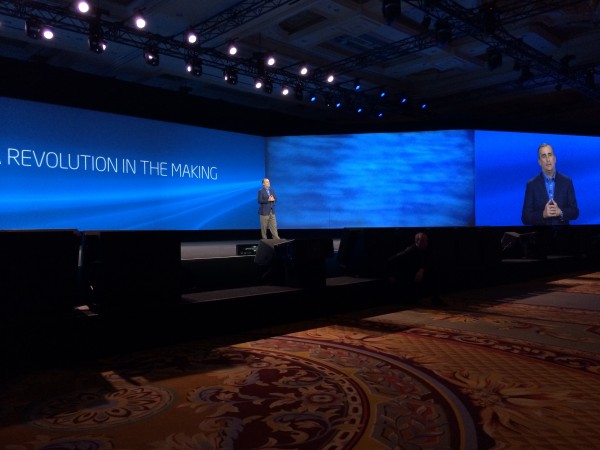Bringing Moore’s Law Off the Desktop and Into the Cloud By Intel CEO at Consumer Electronics Show
LAS VEGAS, January 7, 2014 – Just six months on the job, the new CEO of Silicon Valley computing giant Intel came to the International Consumer Electronics Show here to hail the power of tiny. “Most of my career, computing has been something that you hold in your hand, in your pocket, or that sits
LAS VEGAS, January 7, 2014 – Just six months on the job, the new CEO of Silicon Valley computing giant Intel came to the International Consumer Electronics Show here to hail the power of tiny.
“Most of my career, computing has been something that you hold in your hand, in your pocket, or that sits on a desk,” said CEO Brian Krzanich. “That idea is about to be transformed.”

“We are entering this tiny world,” he said, referring to the Intel Tri-Gate three-dimensional 22 nanometer transistor, and “tiny could not be better.” Future advances toward 14 nanometer transistors are in the works, he said.
Krzanich, an engineer with 32 years of experience at Intel, spoke about a range of technologies and products to be launched by the company in 2014. Most of them rely on this extremely small microprocessor, and include:
- A earbud for music /heart rate monitor combination;
- A smart digital headset, dubbed the Jarvis, that helps you navigate appointments and traveling directions;
- A smart watch with geo-fencing, or the ability for a parent to determine and “fence” in the permissible locations of a young child using the device;
- A wearable smart device, dubbed Edison, taking computing to a new level, including the ability to monitor and communicate information about the sleep pattern and temperature of baby wearing a onesie jumpsuit.
When the baby’s temperature rises or when he or she awakes, Edison communicate with radio-transmitters in the parents’ coffee mug, and also automatically turn on a hot bottle warmer so that it will be ready when the baby awakes.
This “Nursury 2.0” is just one example of “a network of devices, all smart, all working together, all coming to market in 2014,” said Krzanich.
To facilitate an ecosystem of innovation around Edison, Krzanich announced $1.3 billion in prices to design the next big wearable technology. He also said that the company would make its McAfee anti-virus software available for free on all consumer mobile devices.
Krzanich made his “tiny is big” address on Monday night here, the power position at #CES2014 historically dominated — in the era when the personal computer was big — by former Microsoft CEO Bill Gates.
Microsoft famously didn’t have a booth at last year’s CES. Although the software company has “returned” to the show this year, Microsoft no longer has the power position in the marketplace because the company has struggle to make the transition from the desktop world to the m
Neither is Intel , which makes the computing “brains” that live in a range of computers, tablets, phones, and now smaller devices, assured continued success as digital technology makes the next stage of its evolution.obile device world.
But Krzanich argued that innovation is moving away from the keyboard interface, and into a much smaller place. This is the environment in which countless digital devices will be integrated and should work together to positively impact humans’ lives.
In other aspects of his remarks, Krzanich discussed how tablet computers are being more effectively used by businesses, in addition to consumer use. For example, the food chain Applebee’s has met with success by putting Intel-based tablets table-side.
That’s enabled quicker table turnover for the restaurant company. Waiters and waitresses are benefitting too, with 15 percent higher tips, he said.
In another move designed to appeal to the corporate world, Krzanich announced that Intel-based tablets will allow use of both the Android operating system and the Windows 8 operating system for both tablets and computers.
Intel’s Krzanich also highlighted immersive reality, where computing power in creating new games that combine both a physical sandbox and a virtual character who “plays” in the space. He used a similar technology to showcase a giant virtual whale “swimming” around the ballroom where he gave the keynote.
Krzanich also discussed Intel’s commitment to end the struggle over so-called “conflict minerals” obtained from the blood-stained region of central Africa.
And he concluded by re-emphasized the company’s legacy commitment to encouraging scientific education and innovation, showcasing a range of winners of the Intel International Science and Engineering Fair and competition.
Drew Clark is Publisher of BroadbandBreakfast.com and tracks the development of Gigabit Networks, broadband usage, the universal service fund, and wireless spectrum policy at http://twitter.com/broadbandcensus. Nationally recognized for his knowledge on telecommunications law and policy, Clark brings experts and practitioners together to advance the benefits provided by broadband: job creation, telemedicine, online learning, public safety, the smart grid, eGovernment, and family connectedness. Clark is also available on Google+ and Twitter.









Member discussion